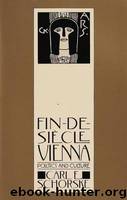Fin-De-Siecle Vienna: Politics and Culture by Schorske Carl E

Author:Schorske, Carl E. [Schorske, Carl E.]
Language: eng
Format: epub
Tags: History
ISBN: 9780307814517
Goodreads: 13530888
Publisher: Random House Digital, Inc.
Published: 1996-04-15T00:00:00+00:00
* Schönerer’s drive, business acumen, and ruthlessness emerged in this first venture, where he replaced the chief designer, his own teacher, by siding with economy-minded directors against him. See Oesterreichischer Eisenbahnbeamtenverein, Geschichte der Eisenbahnen der Oesterreichisch-Ungarischen Monarchie (Vienna, Teschen, and Leipzig, 1897–1908), I, Part i, 99–101.
† An urn presented to Schönerer by his loyal personnel in 1846, when he was director of the Vienna-Gloggnitz Railway, celebrated his many talents with the iconographic variety characteristic of the age: Minerva stood for “Civil Engineering”; Mercury was elevated from his traditional role as trickster and divine messenger to represent “Administration”; a locomotive joined the pantheon to present “Railway Management,” while an anvil, labeled “Machine Construction,” completed the quartet of symbols. Cf. Constantin von Wurzbach, Oesterreichische Nationalbiographie (Vienna, 1856–91), XXXI, 149.
* The Klub was the basic unit of party organization within the Parliament. A party was a loose structure generally composed of several such groups.
* These included, among others, Victor Adler and Engelbert Pernerstorfer, later leaders of Social Democracy; Robert Pattai, later Christian Social leader; and Heinrich Friedjung, the liberal historian. The group had its origins primarily in a university students’ organization, the Leseverein der deutschen Studenten Wiens (1871–78). See William J. McGrath, “Student Radicalism in Vienna,” Journal of Contemporary History, II, No. 2 (1967), 183–95.
* In 1885, Szeps spent a month in jail as the result of a successful libel action brought against him by Schönerer. See Bertha Szeps-Zuckerkandl, My Life and History, tr. John Sommerfield (London, 1938), pp. 86, 91, 95.
* “Politik ist Magie. Welcher die Mächte aufzurufen weiss, dem gehorchen sie.”
* The importance of this academy to the high nobility of blood and service may be gauged by the fact that the establishment of a secure quota of places for the scions of prominent Hungarian families became a matter of high-level negotiations between the Austrian and Hungarian administrations after the establishment of the dual monarchy in 1867 (Eugen Guglia, Das Theresianum in Wien. Vergangenheit und Gegenwart [Vienna, 1912], pp. 156–7). The post of Curator of the Theresianum, the equivalent of the chairman of the board of trustees in an American school, generally fell only to a figure of national prominence. When Lueger entered the school in 1854, the curator was Count Taafe, father of the minister president during whose tenure of office Lueger was to rise to prominence. Another chief of government, Anton Ritter von Schmerling, occupied the school’s curatorship from 1865 to 1893, while his successor, Baron Paul Gautsch von Frankenthurn, became minister president of Austria in 1897, the year when Lueger finally realized his dream of becoming mayor of Vienna.
† Some bourgeois families were too proud of their station to expose their sons to the snobbish aristocratic milieu of the Theresianum. The favorite Gymnasium of the secular liberal—and the Jew—was the Akademisches Gymnasium. Cf. Karl Kautsky, Erinnerungen und Erörterungen (’s-Gravenhage, 1960), p. 211.
* The date is unclear because of the years of slow regrouping of the entities that composed the new movement.
* “Let others wage war.
You, happy Austria, marry [to prosper]….
Download
This site does not store any files on its server. We only index and link to content provided by other sites. Please contact the content providers to delete copyright contents if any and email us, we'll remove relevant links or contents immediately.
| Africa | Americas |
| Arctic & Antarctica | Asia |
| Australia & Oceania | Europe |
| Middle East | Russia |
| United States | World |
| Ancient Civilizations | Military |
| Historical Study & Educational Resources |
Room 212 by Kate Stewart(4739)
The Crown by Robert Lacey(4573)
Endurance: Shackleton's Incredible Voyage by Alfred Lansing(4507)
The Iron Duke by The Iron Duke(4122)
The Rape of Nanking by Iris Chang(4023)
Killing England by Bill O'Reilly(3898)
Joan of Arc by Mary Gordon(3784)
Say Nothing by Patrick Radden Keefe(3725)
I'll Give You the Sun by Jandy Nelson(3273)
Shadow of Night by Deborah Harkness(3176)
Hitler's Monsters by Eric Kurlander(3164)
Mary, Queen of Scots, and the Murder of Lord Darnley by Alison Weir(3066)
Blood and Sand by Alex Von Tunzelmann(3058)
Darkest Hour by Anthony McCarten(3018)
Margaret Thatcher: The Autobiography by Thatcher Margaret(2971)
Eleanor & Park by Rainbow Rowell(2943)
Red Famine: Stalin's War on Ukraine by Anne Applebaum(2816)
Book of Life by Deborah Harkness(2720)
The One Memory of Flora Banks by Emily Barr(2685)
